and François Moutet2
(1)
Marseille, France
(2)
Grenoble, France
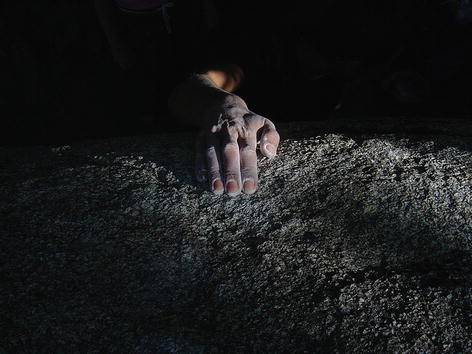
Photo 6.1
6.1 Assessment
More and more young people practice climbing at a higher and higher level. Trying to reach excellence implies a rise in the number of training sessions and in the duration of these sessions, which consequently leads to an increase in injuries. Most of the common pathologies are found with high-level climbing. Indeed, finger structures are extremely strained at that level. In a way, just like highly skilled climbers, the common climber also wants to be a good performer, but contrary to the former one, the latter does not follow strict rules, which could nonetheless help him to reduce risks as regards possible lesions.
The ordinary climber does not usually respect climbing basics such as good stretching exercises, proper hydration, or the simple fact of listening to his body.
Most of the time, the climber doesn’t pay attention to the pain and prefers carrying on his practice rather than stopping it. He makes his own diagnosis, which often leads to a bad treatment of the lesion. This behavior seems to result in a rise in recurrences and/or chronic pains. In some cases, climbers accumulate the amount of mistreated injuries.
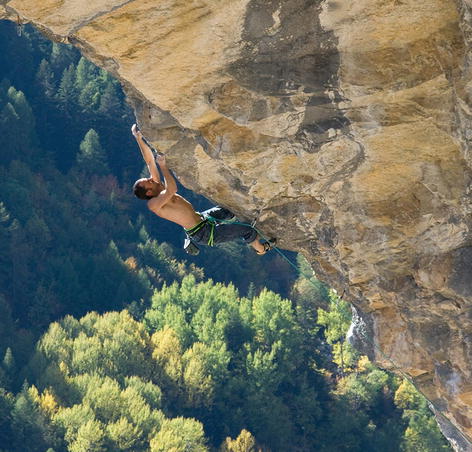

Photo 6.2
6.2 Warm-Up
Most of the time, warm-up is neglected and regarded as a waste of time. It is rare to see climbers warming up properly and gradually. Whatever sport one may practice, the first thing to do is of course to warm up. And fingers can’t be neglected. According to one’s climbing level, even the easy parts of a route may be a strain for the different muscles and joints involved. This is why the entire body and the hand of course have to be warmed up properly.
To assure a safe climbing, it is important to start any session with a gradual body preparation. Muscles and joints need a certain time to adjust to climbing specificities. Once again, let us remember that fingers have not been first conceived to climb, so they have to be well prepared. Warm-up is not only a physical preparation but also a psychological one.
The top priority is to have one’s mind-set on the ongoing activity. Some of the lesions depicted in this book resulted from a lack of concentration. For instance, a loss of focus during the tight seizing of the hold on a dynamic movement may end up into a twisted finger. Therefore, it is important to warm up one’s fingers before starting the session.
From a physical point of view, athletes’ intensity and performance are better after an adequate and gradual warm-up. Muscles and tendons reach a rest temperature of 36°C; it rises to 39°C in full activity. At that temperature, reactivity from a nerve impulse is faster. Therefore, the risk to get hurt is reduced, thanks to a sharper concentration and a better tendon or muscle elasticity. All these factors benefit the athlete and lower the risks of injuries.
Warm-up has to be adjusted to the athlete’s climbing specificities and the aim of the session. A session based on pure strength has to be longer and more particular, especially as regards fingers. In cold weather, warm-up needs to be longer, and the climber has to wear gloves after, to keep his hands warm. A sudden fall in the temperature of the fingers can be avoided by the use of a finger warmer.
The time of the day, when the climber practices, is also to be considered. On early morning, warm-up has to be longer. Indeed, after a long night, the body – fingers included – is still numb and consequently not ready to react properly or make any effort.
This book deals with hand and finger specificities, so the athlete will find some warm-up exercises below.
6.2.1 Warm-Up: First Part
The first exercises are done without touching any hold.
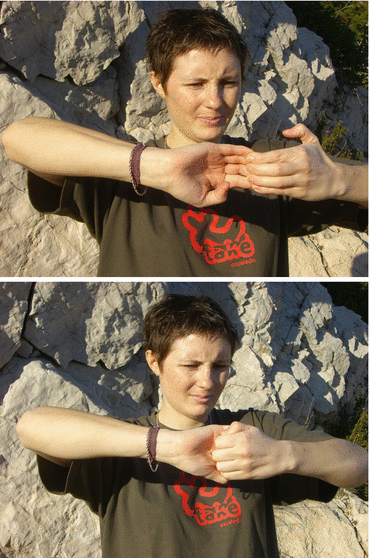
1.
Hold your fists tight, and then open up your hand for 50 times.
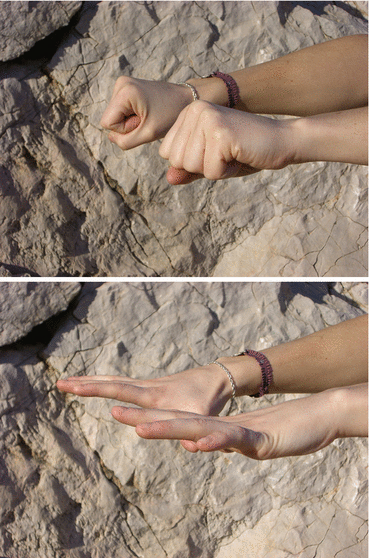

Photos 6.3 and 6.4
2.
Bend on your knees and rotate your hands on the ground for 3 min.
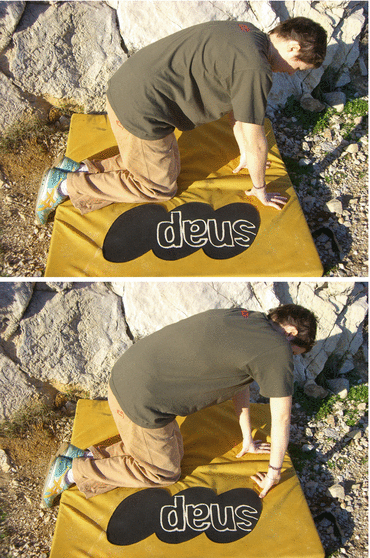

Photos 6.5 and 6.6
3.
Fold up and fold back your fingers for 30 s.

Photos 6.7 and 6.8
6.2.2 Warm-Up: Second Part
Passive stretching exercises complete this specific warm-up. Stretching exercises: Short stretching movements, from 5 to 10 s, have to be done. What matters is not working on suppleness but awakening the body. Coupled with basic climbing movements, they prepare the body to the effort.
Fingers can also be warmed up by using a rubber ball or some modeling clay.
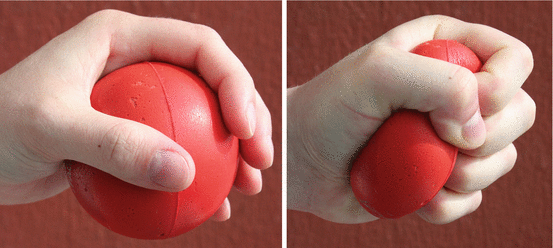

Photos 6.9 and 6.10
6.2.3 Warm-Up: Third Part
After these series of exercises, the climber gradually seizes holds on a hangboard. He can start with suspensions using his two hands to seize large holds and then try on smaller and various grips such as two-finger pockets. The athlete ends up his preparation by hanging on with only one hand. For instance, he can remain suspended for 5 s and get a 15 s break.
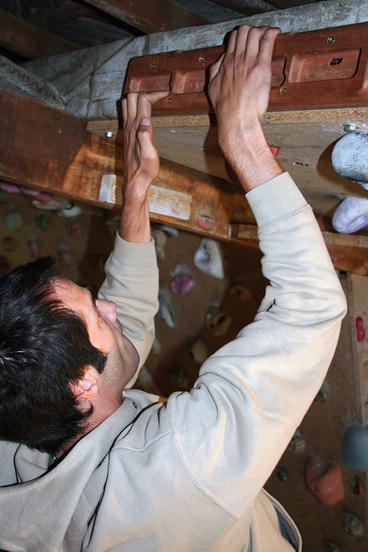

Photo 6.11
6.2.4 Warm-Up: Fourth Part
The athlete does traverses using all the hangboard holds. He also gradually stretches all the different muscles, alternating open hand and crimp grip posture.
Finally, he can make several attempts, lower to his top level. As the session unfolds, the movements get more and more specific and complex.
The general and specific warm-up has to last about 20 min. The body is prepared to make a top effort after 1 h of warm-up.
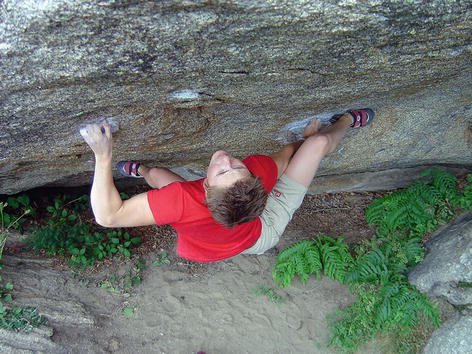

Photo 6.12
6.3 Stretching Exercises
Whether in climbing gyms or on cliffs, it is quite usual to see climbers practice intensively without doing any stretching exercises before or after. Nonetheless, some of these climbers will make a few climbing movements, which actually will do nothing but stretch the forearms, rather than stretch the fingers for real.
Despite that, 37 % out of the injured climbers confess that their lesions may have come from that fact. And 67 % out of the other climbers stretch while they are climbing. After a lesion, most of them had to get into the habit of looking after their fingers by stretching them after each session. These habits concerning a healthy body should be common knowledge, and the athletes should not wait to be injured to finally become aware of that phenomenon.
6.3.1 Stretching Exercises: What For?
Stretching one’s body is an important part of the training.
Before any effort, stretching exercises are a means to warm up muscles, tendons, and joints and consequently to prepare the body to a physical effort.
After any effort, these exercises help promote recovery quickly by evacuating the waste and the effects of tiredness. They also allow the restoration of the muscle’s initial size.
Between two efforts, stretching exercises make the recovery better and consequently the preparation for the next climbing attempt more efficient.
The function of stretching sessions is to maintain muscle and joints’ precision and quality. Doing stretching exercises regularly prevents the athlete from losing flexibility throughout the years.
The ultimate goal of stretching exercises is to accelerate the healing of a lesion by reducing joint and muscle stiffness, after stopping climbing or after an immobilization.
6.3.2 Stretching Basics
Stretching exercises have to be part of each training session. The exercises may differ according to the athlete’s capacities.
Several safety recommendations have to be followed.
Stretching exercises must not be done unprepared. The athlete’s muscles and joints have to be warmed up first.
Muscles have to be tensed smoothly. No pain must be felt. Actually, the pain reveals the limit which must not be over-crossed. When a sportsman can’t do an exercise properly, he has to adjust it or choose another one.
A limb has to be stretched slowly and gradually, with no dash. Gathering impetus to be more efficient on the muscle is a wrong idea and might cause an injury.
The stretching posture has to be maintained for about 15 s to be optimal. It is the requested time to allow the muscle to regain its original size little by little.
Breathing is the key word during stretching exercises. Throughout the exercises, the athlete has to breathe regularly. He has to breathe out while stretching and he must not stop breathing while he is holding the position.
Throughout the exercises, it is important to stay focused and also to listen to one’s body to feel the muscles’ gradual tension.
Long passive stretching exercises improve the muscles’ recovery at the end of the training session. These kinds of exercises reinforce flexibility, but they don’t prepare the muscles to an immediate effort. Therefore, it is forbidden to do these sorts of exercises before an important effort.
6.3.3 Finger Flexors
For sure, these muscles are the most involved in climbing, as characterized by the presence of acidosis in the forearms due to the tight seizing of the holds. Therefore, these muscles have to regain their initial size. The fact that climbers’ hands look like those of monkeys is due to the fact that they never stretch their muscles, which eventually get shorter.
An ordinary person is supposed to be able to straight out his hand with an angle of 90°, without using the other hand.
6.3.3.1 Stretching Exercise 1
The sportsman bends on his knees with his hand on the ground and fingers directed to the knees. The hand and the palm have to be in contact to the surface. The elbows are tensed. To maintain the hands in contact to the ground, the climber may have to bend forward.
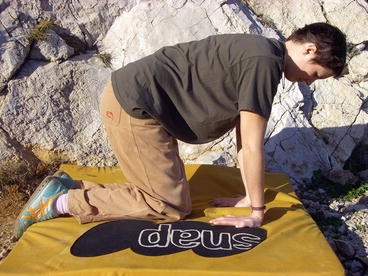

Photo 6.13
Holding his hand flat on the ground and his elbows tensed, the climber goes backward slowly directing his back and bedpan toward his feet. As soon as the muscle is tensed, he holds the position for 15–30 s with no dash and repeats the exercise six times.
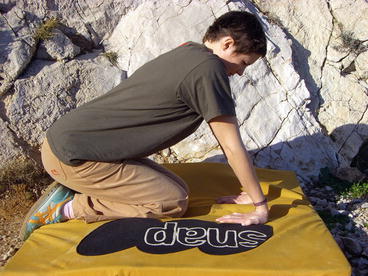

Photo 6.14
6.3.3.2 Stretching Exercise 2
Standing, the climber rests his fingers on the other hand. Helping himself with the thumb, which is stuck to the palm, the climber tenses the forearm muscle, stretching out the wrist and holding the fingers backward. He holds the position for 15–30 s and repeats the exercise six times.
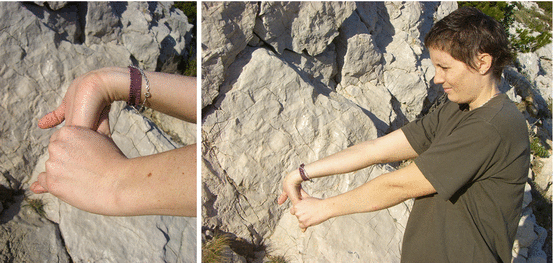

Photos 6.15 and 6.16
6.3.3.3 Stretching Exercise 3
Standing, the climber puts the tips of his fingers on a table so that he can tense his arms. He flexes his muscles by pressing his wrists slightly and downward. He holds the position for 15–30 s and repeats the exercise six times.
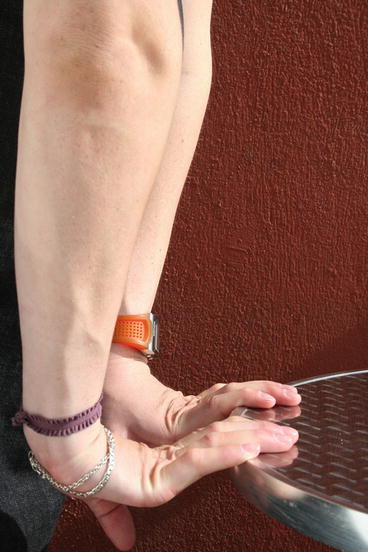

Photo 6.17
6.3.4 Finger: Common Extensors
The use of this muscle is hardly known by climbers, and there stands the hitch. This is why it can’t be underestimated. Just like flexors, an ordinary person has to be able to stretch out his fingers, when his wrist is flexed to 90 %.
During the exercise, the tightening of the muscle is felt on the posterior side of the forearm.
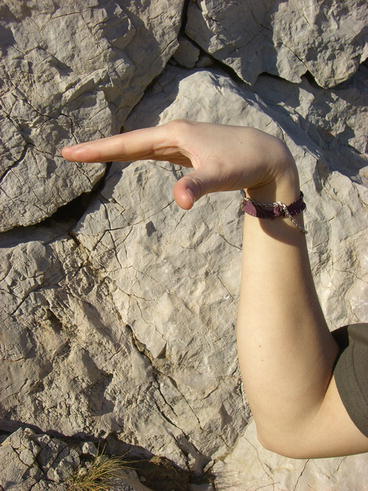

Photo 6.18
6.3.4.1 Stretching Exercise 1
Standing or sitting, the climber has to fold the elbow, the wrist, and the fingers. He uses the second hand as a support to the first one.
The aim is to stretch the elbow and flex the wrist as much as possible. He holds the position for 15–30 s and repeats the exercise six times.
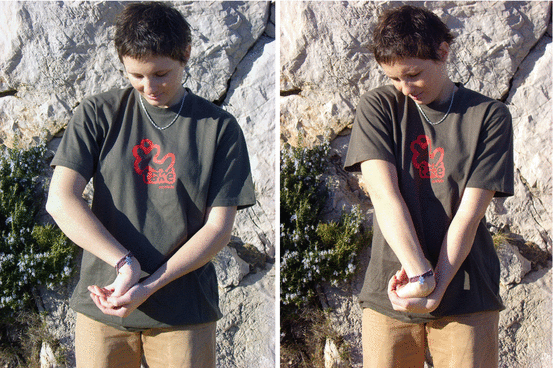

Photos 6.19 and 6.20
6.3.4.2 Stretching Exercise 2
Standing or sitting, the climber has to join all his fingers – thumb included – in a straight posture. With the other hand, he flexes the wrist. The aim is to extend the elbow. He holds the position for 15–30 s and repeats the exercise six times.
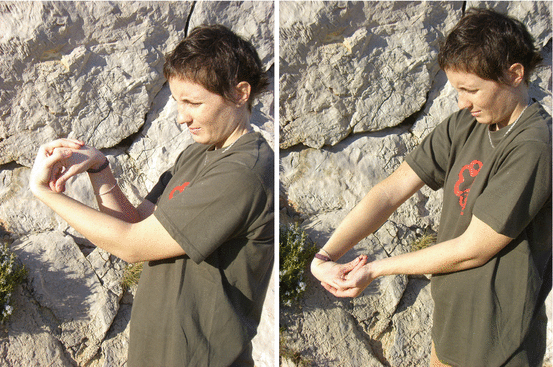

Photos 6.21 and 6.22
6.3.5 Interosseous Muscles
Most of the climbers don’t know anything about these muscles. Nonetheless, they play a major part in finger coordination and joint stability. If these muscles are too short and tight, a dysfunction in the hand may appear. It is highly recommended to pay particular attention to those little muscles.
The tension has to be felt in the palm of the hand.
6.3.5.1 Stretching Exercise 1
To do this exercise properly, the forearm and the palm lean on a straight surface such as a table. It is advised to keep the fingers in the air. The climber has to fold the finger – around the PIP joint – he wishes to stretch. The same exercise can be done without leaning on a table.
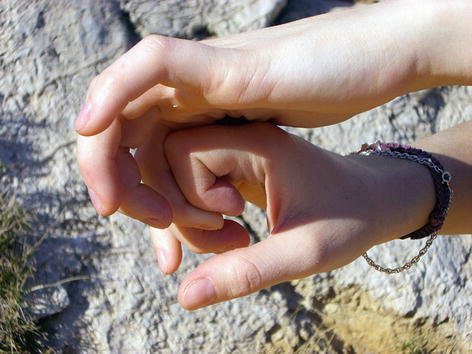

Photo 6.23
The climber wraps his hand with the second one and seizes the folded finger to stretch it. He pulls the folded finger backward flexing the metacarpal joint. He holds the position for 15 to seconds and repeats the exercise six times.
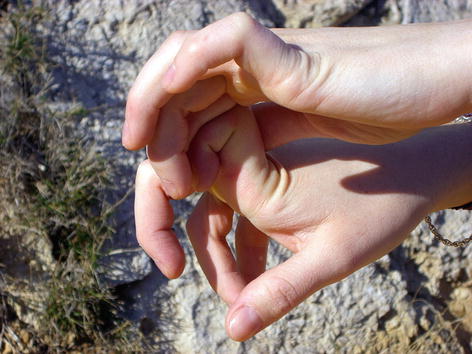

Photo 6.24
6.3.5.2 Stretching Exercise 2
Do the exercise mentioned above, but this time folding the four fingers of the hand.


Photo 6.25
6.3.5.3 Stretching Exercise 3
The climber has to put his palm upward and then fold the finger inwardly, just as reported in the first stretching exercise.
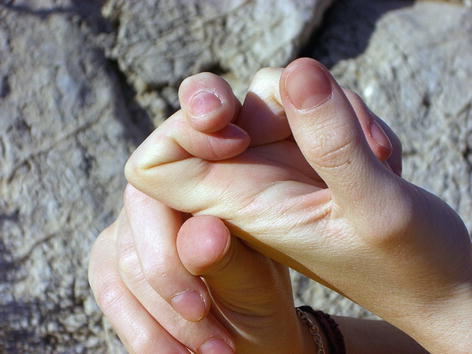

Photo 6.26
The climber uses his second hand to seize the folded finger around the third phalanx area and pulls it backward in the direction of the arm.
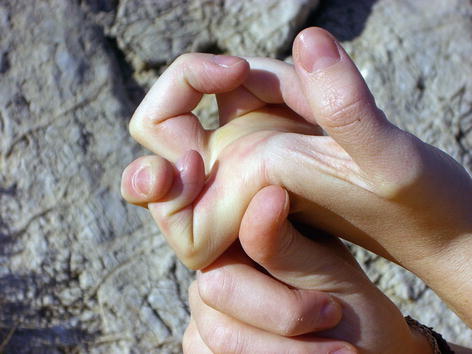

Photo 6.27
6.4 Dehydration
Dehydration is one of the causes of climbing injuries. Other factors can aggravate this problem according to the climbing sites – outdoors or indoors. In summer time, climbers are more exposed to heat, due to the reflection of the sun over the cliffs. A sunny weather with no wind is also another factor, which is hardly taken into consideration by climbers. On the other hand, according to Rubio, “when sport is practiced at high level, dehydration is higher in gyms than outdoors, because it is hotter.” The ideal place should be “not too humid, cool, and well ventilated.” Climbing involves dehydration problems depending on outdoor or indoor sites.
“When you are thirsty.., it’s already too late….” The body is informed that water is lacking when one starts feeling thirst, it’s the signal of dehydration, that is to say, water supplies are lower than waste. The mouth and the throat get dryer and less saliva is secreted.
The body is composed of 60–70 % of water. The body fights against heat by sweating. During any activity, heat comes out of the body. Therefore, to maintain the right inner temperature, the body needs to eliminate that heat. Evaporation is one of the means to eliminate heat, and it can be defined in two steps: sweating and the transformation of this sweat into steam, which is the only method to lower the body temperature.
A lack in water can lead to cramps, tendinitis, and renal calculus. Therefore, a sportsman suffering from dehydration is bound to perform badly. Indeed, 2 % of dehydration equals to 20 % loss in performance. For a person weighing 70 kg, it represents a loss of 1.4 l of water.
When people don’t practice any physical activities, half of the water supply is provided by food diet. Therefore, to make up for the lack, it is necessary to drink about 1.5–2 l a day. When people do sports, the loss of water is higher, so it is advised to drink before, during, and after the activity to make up for that additional loss of water. Depending on the temperature, the need in water can be more important for climbers. Therefore, it is a priority to drink before feeling the thirst.
Unfortunately, the body can’t store all the water, so it is completely useless to drink a great amount of liquid before any effort, because that water won’t make up for the later loss. On the other hand, it is important to be well hydrated before any effort in order to perform well but also to avoid any muscle or tendon lesions.
During the effort, the athlete has to drink regularly every 10–15 min, but it is forbidden to drink 1 l of water at one go.
Stay updated, free articles. Join our Telegram channel

Full access? Get Clinical Tree








